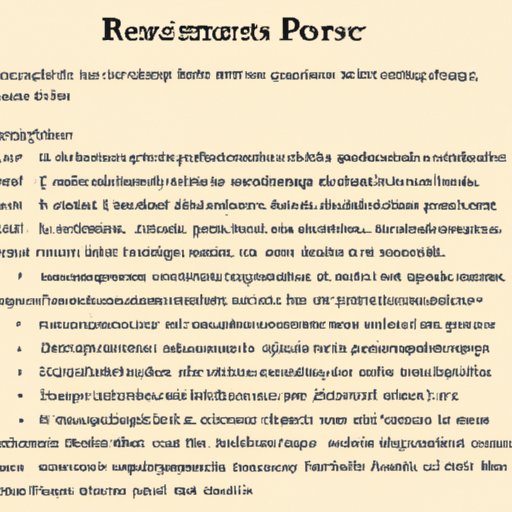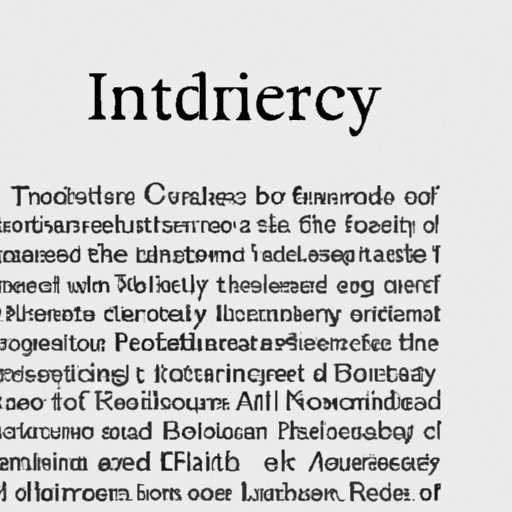Introduction
Political science is the study of power, politics, and public policy. It is an interdisciplinary field of study that incorporates elements of sociology, economics, history, and psychology. Writing a research paper in this field requires an understanding of the different components of a research paper and how they are used in the analysis of political events and issues. This article provides an overview of the essential components of a political science research paper and tips for conducting an effective research process.

Components of a Political Science Research Paper
A political science research paper typically includes a thesis statement, research question, literature review, primary and secondary sources, and analysis and conclusion. The thesis statement is a clear and concise statement that summarizes the main point of the paper. The research question is a specific inquiry about a particular topic that guides the research process. The literature review is an examination of the existing information on a given topic. Primary and secondary sources provide additional evidence and support for the paper’s claims. Finally, the analysis and conclusion section evaluates the data and draws conclusions from the research.
Research Process
The research process begins with identifying a topic of interest. After selecting a topic, the next step is to narrow the scope of the topic to create a more manageable research project. Once the scope of the project has been determined, the researcher can then develop a research question to guide the research process.
Thesis Statement
A thesis statement is a single sentence that expresses the main idea of the paper. It should be clear and concise and should accurately reflect the content of the paper. The thesis statement serves as the foundation of the paper and provides direction for the rest of the research. Developing an effective thesis statement is an important part of the research process and can help ensure that the research paper is organized and focused. Here are some tips for developing an effective thesis statement:
- Be specific – don’t make generalizations or vague statements
- Focus on one main idea – don’t try to cover too much ground
- Make sure the statement is supported by evidence – avoid making unsubstantiated claims
Literature Review
A literature review is an analysis of existing information on a particular topic. It is an important part of the research process as it helps to identify the current body of knowledge on a topic and provides a framework for the research. The literature review should include a discussion of relevant theories, methods, and findings. Here are some key elements of an effective literature review:
- Identify the gap in existing knowledge – what new information is needed
- Identify relevant sources – both primary and secondary sources
- Evaluate sources – assess the credibility and accuracy of each source
- Synthesize information – organize and summarize the information from sources
Here are some tips for conducting an effective literature review:
- Start early – begin researching and reading as soon as possible
- Take notes – keep track of ideas, quotes, and other information
- Be organized – use an outline to help organize your thoughts
- Be critical – evaluate the sources to determine their validity and relevance
Using Primary and Secondary Sources
Primary sources are original documents or artifacts that provide firsthand accounts of events. Examples of primary sources include speeches, interviews, photographs, and newspaper articles. Secondary sources are interpretations or analyses of primary sources. Examples of secondary sources include books, journal articles, and websites. When using primary and secondary sources, it is important to consider the credibility and accuracy of the source. Here are some tips for using these sources effectively:
- Verify the accuracy of the source – check for bias and look for multiple perspectives
- Evaluate the quality of the source – look for reliable sources with good reputations
- Check the date of the source – make sure the source is up-to-date and relevant
- Analyze the source – consider the context of the source and its implications
Conclusion
Writing a political science research paper can be a challenging task, but with the right approach it can be a rewarding experience. By understanding the components of a research paper and following the research process, researchers can create an effective and informative paper. The thesis statement and literature review are two of the most important components of a research paper, as they provide the foundation for the rest of the paper. Using primary and secondary sources is also essential for providing evidence and support for the paper’s claims. With these tips, researchers can confidently write a political science research paper.
(Note: Is this article not meeting your expectations? Do you have knowledge or insights to share? Unlock new opportunities and expand your reach by joining our authors team. Click Registration to join us and share your expertise with our readers.)
